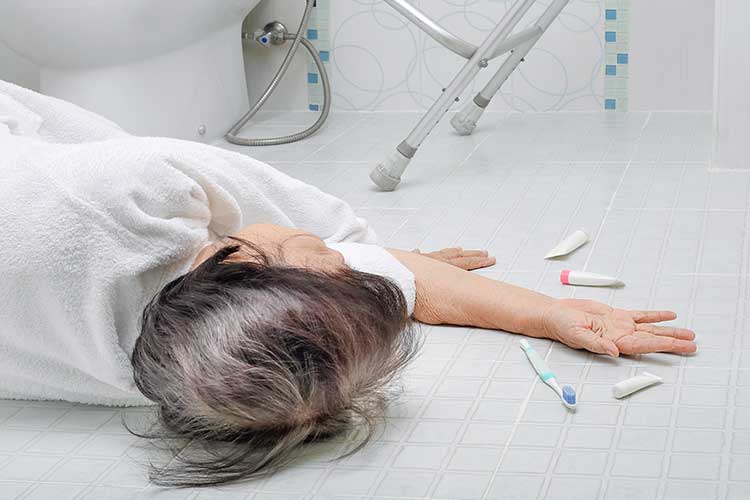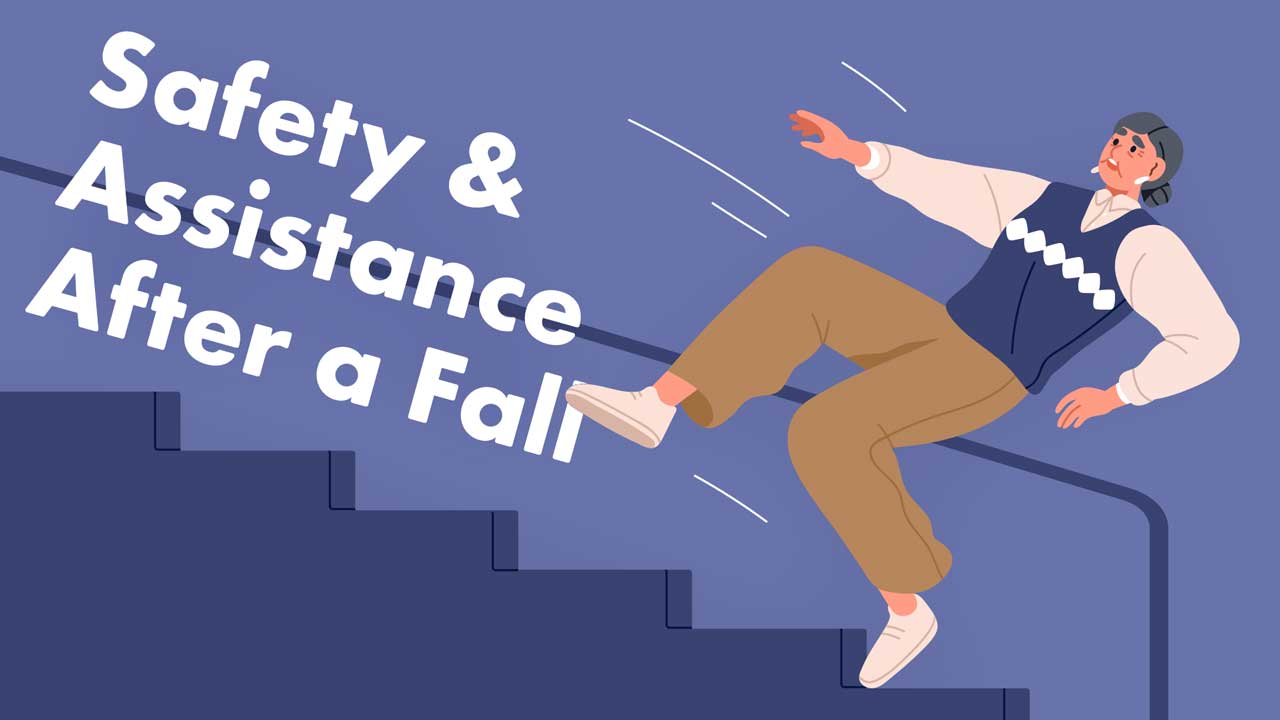While preventing falls before they happen is the best line of defence for managing falls, this is not always possible, and clients in your care will inevitably fall from time to time.
Falls are common in older people in particular and are a major cause of injury. Even minor falls have the potential to cause serious injury or even death in vulnerable clients (Healthdirect 2023; VIC DoH 2023).
Knowing how to best respond and provide immediate assistance to a person who has fallen is crucial in preventing further harm and distress to your clients in cases when the fall can not be prevented.
Immediately After a Fall
- Perform a DRSABCD assessment (Danger, Response, Send for help, Airway, Breathing, CPR, Defibrillator).
- Reassure and comfort the person.
- Call for help.
- Do not attempt to move the person until you have performed a head-to-toe assessment and assessed safety.
- If the person has a physical injury, they must not be moved.
- If the person is unconscious, perform basic life support and call for emergency services.
- If the person is experiencing head or neck pain, do not move them until a medical practitioner arrives (only if it is safe to do so).
- Move the person if deemed appropriate upon clinical assessment. This should be performed by an experienced nursing or medical practitioner (always follow your organisation’s policies and procedures).
- Increase the frequency of observations, including neurological assessment and baseline physical observations such as pulse, blood pressure, oxygen saturation, respiratory rate and conscious state, and conduct a pain assessment.
- If necessary, consider administering pain relief if you are authorised to do so, to ensure the person is made comfortable before moving them safely.
- Call for manual handling equipment such as lifting machines, inflatable mats etc. if applicable and appropriate for the person and the environment.
- Undertake the following investigations if required:
- Blood glucose level (consider this test if the person is known to have diabetes or there is an altered state of consciousness)
- Electrocardiogram (ECG) (if the environment is safe to do so, free from water and hazards, etc.)
- Cognitive impairment screening (refer to your organisation’s policies and procedures)
- If the person has sustained significant physical injuries, escalate care to assigned medical services to ensure timely care is received within 30 minutes (always follow your organisation’s policies and procedures).
- Investigate any pre-fall symptoms, such as dizziness or unsteadiness or any other factors that may have contributed to the fall and the client’s condition.
- Notify the registered nurse or facility manager and escalate care accordingly. In an emergency, call 000 directly if required.
(WA DoH 2023; Queensland Health 2024)

Assessing Signs of Fall Injuries
Signs that the person may have sustained a serious injury from the fall include:
- Bruising around both eyes
- Cerebrospinal fluid leaking from the ears or nose
- Midline cervical, thoracic or thoracolumbar spine tenderness
- Respiratory distress
- Subcutaneous emphysema (air trapped under the skin)
- Abdominal or pelvic tenderness
- Macroscopic haematuria (blood in urine) with haemodynamic instability
- Leg shortening/external rotation with hip or groin pain.
(Queensland Health 2024)
Note: People with a known coagulopathy (blood clotting disorder) or who are taking anticoagulants or antiplatelet therapy are at increased risk of intracranial, intrathoracic or intra-abdominal haemorrhage (WA DoH 2023).
Within the First Four Hours After a Fall:
- Conduct a medical review of the person
- Determine factors that contributed to the fall and take appropriate action to decrease the risk of subsequent falls or injuries.
(WA DoH 2023)
Within the First Six Hours After a Fall:
- Notify the person’s next of kin and begin open disclosure processes
- Monitor for physical, behavioural, cognitive and clinical deterioration, and escalate if required
- Ensure medical officer reviews any urgent medical tests
- Notify relevant healthcare professionals about the fall as required
- Refer the person to relevant healthcare professionals if required
- Ensure factors that contributed to the fall have been identified and appropriate action has been taken to decrease the risk of subsequent falls or injuries
- Re-screen the person using a falls risk assessment tool (refer to your organisation’s policies and procedures)
- Document and report the fall according to local policies and procedures.
(WA DoH 2023)
Within the First 24 Hours After a Fall:
- Continue to monitor for any signs of physical, behavioural or cognitive deterioration and escalate care as required
- Review and action test results, e.g. bloods, imaging, microbiology, observations
- Review the fall and implement appropriate falls prevention strategies in response to the incident
- Develop falls management strategies together with the patient/family/carers and provide education where required
- Discuss the incident with the interprofessional team, identify further interventions required and put these into place
- Consider a structured interprofessional post-fall safety discussion.
(WA DoH 2023)
Post-Fall Interventions

Falling once doubles the risk of falling again in the future (CDC 2024).
For this reason, after a fall, it is essential that actions are taken to reduce the risk of another fall. These interventions should be performed within 24 hours (AHRQ 2017).
Depending on the cause of the fall, immediate interventions may include:
- Increased toileting with more assistance from staff
- More staff assistance and supervision for high-risk situations
- More monitoring of the client
- Pain management
- Safer footwear
- A low bed or mat, as long as it does not restrict the person from moving freely
- Behaviour management strategies.
(AHRQ 2017)
Within the First 48 Hours After a Fall:
- Review the client’s observations. If there is no sign of clinical deterioration, return to appropriate observations
- Complete all actions that are outlined in your organisation’s post-fall policies and procedures
- Undertake a comprehensive review of the client’s care plan
- Document and communicate any further actions required.
(WA DoH 2023)
Look out for the following symptoms, which may indicate deterioration and require an escalation of care:
- Deterioration of vital signs
- New onset of altered mental state
- New onset of impaired mobility, painful bony deformity, or hip pain accompanied by reduced range of motion or shortening/leg rotation
- Signs indicative of head trauma:
- Severe headache
- Cerebrospinal fluid leakage from nose/ears
- Bruising around the eyes, mastoid process or bony prominences behind the ears
- Seizure
- Vomiting two or more times.
(Queensland Health 2023)
Communication
After a fall, ensure that:
- All required documentation has been completed by the primary carer, nurse or healthcare worker in the client’s records, as well as in the local reporting database
- The client and their family understand the event and the ongoing care that is being provided
- Communication approaches are appropriately tailored to the person’s disability and/or culture (e.g. the use of interpreters)
- The fall has been discussed in handovers between clinical care staff members
- A debrief session occurs after the fall with all of the staff who were involved
- Visual signs indicating the client’s falls risk are displayed in their room (adhere to your organisation’s policies and procedures).
(WA DoH 2023)
Within the First Week After a Fall:
In the first few days following the fall, the person may experience mild symptoms such as:
- Minor headaches
- Irritability, anxiety or tearfulness
- Concentration or memory difficulties
- Nausea
- Dizziness
- Reduced appetite
- Sleeping difficulties
- Fatigue.
(SOYFWA 2018)
Escalate care if these symptoms worsen or persist for over one week (SOYFWA 2018).
Documenting the Fall

All falls must be documented and reported (VIC DoH 2023).
The following details must be documented in the client’s medical record:
- The client’s observations, appearance or response to the fall
- Evidence of any injuries
- Location of the fall
- Notification of medical provider
- Actions that were taken in response to the fall.
(ACSQHC 2009)
A falls reporting form must also be completed for all falls, regardless of where the fall occurred and whether the client was injured (refer to your local policies and procedures) (ACSQHC 2009).
The report should, at a minimum, include the following details:
- The client’s description of the fall (if possible)
- The location and time of the fall
- What the client was doing immediately before falling
- Mechanism of the fall (e.g. slip, trip, overbalance, dizziness)
- Whether the client lost consciousness.
(ACSQHC 2009)
Falls and Major Injury Under the National Aged Care Mandatory Quality Indicator Program
Under the National Aged Care Mandatory Quality Indicator Program, all government-subsidised residential aged care providers must collect and report data on falls that occurred within their organisation every quarter (DoHDaA 2025).
This process should involve reviewing the care records of all care recipients for the quarter and reporting the required data, which is:
- The number of care recipients whose records were assessed for falls and major injury
- The number of care recipients excluded because they were absent from the service for the entire quarter
- The number of care recipients who experienced a fall (one or more) at the service during the quarter
- The number of care recipients who experienced a fall at the service, resulting in major injury (one or more), during the quarter.
(DoHDaA 2025)
Note: A fall resulting in major injury is defined by the QI Program manual as a fall that resulted in a bone fracture, joint dislocation, closed head injury with altered consciousness and/or subdural haematoma.
Test Your Knowledge
Question 1 of 3
What is the first action a caregiver should take immediately after a client has fallen?
Topics
Further your knowledge
 Free
Free Free
Free Free
Free Free
Free
References
- Agency for Healthcare Research and Quality 2017, The Falls Management Program: A Quality Improvement Initiative for Nursing Facilities: Chapter 2. Fall Response, AHRQ, viewed 18 June 2025, https://www.ahrq.gov/patient-safety/settings/long-term-care/resource/injuries/fallspx/man2.html
- Australian Commission on Safety and Quality in Health Care 2009, Preventing Falls and Harm From Falls in Older People: Best Practice Guidelines for Australian Hospitals, Australian Government, viewed 18 June 2025, https://www.safetyandquality.gov.au/sites/default/files/migrated/Guidelines-RACF.pdf
- Centers for Disease Control and Prevention 2024, Facts About Falls, U.S. Department of Health and Human Services, viewed 18 June 2025, https://www.cdc.gov/falls/data-research/facts-stats/index.html
- Department of Health, Disability and Ageing 2025, QI Program Quick Reference Guide – Falls and Major Injury, Australian Government, viewed 18 June 2025, https://www.health.gov.au/resources/publications/qi-program-quick-reference-guide-falls-and-major-injury?language=en
- Healthdirect 2023, Older People and Falls, Australian Government, viewed 17 June 2025, https://www.healthdirect.gov.au/falls
- Queensland Health 2023, Falls, Queensland Government, viewed 18 June 2025, https://www.health.qld.gov.au/clinical-practice/guidelines-procedures/clinical-pathways/residential-aged-care-clinical-pathways/all-pathways/falls
- Queensland Health 2024, Residential Care Facility/ Multipurpose Health Service Post Fall Clinical Pathway, Queensland Government, viewed 17 June 2025, https://www.health.qld.gov.au/__data/assets/pdf_file/0023/431537/fall-rcf-post.pdf/_nocache
- Stay on Your Feet WA 2018, Health Advice Following a Fall, Government of Western Australia, viewed 18 June 2025, https://www.health.wa.gov.au/~/media/Files/Corporate/general-documents/Health-Networks/Falls-prevention/180831_HealthAdviceFollowingAFall_FINAL.pdf
- Victoria Department of Health 2023, Falls - Standardised Care Process, Victorian State Government, viewed 17 June 2025, https://www.health.vic.gov.au/residential-aged-care/standardised-care-processes
- Western Australia Department of Health 2023, Post Fall Multidisciplinary Management Guidelines for Western Australian Health Care Settings 2023, Government of Western Australia, viewed 17 June 2025, https://www.health.wa.gov.au/~/media/Corp/Documents/Health-for/Falls/Post-Fall-Multidisciplinary-Management-Guidelines-2023.pdf

